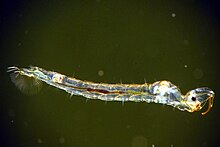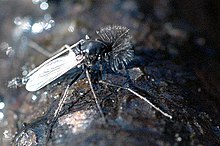Glassworm
| Glassworm | |
|---|---|
 |
|
 |
|
| Aquatic larvae (above) and winged adult (below) | |
| Scientific classification | |
| Kingdom: | Animalia |
| Phylum: | Arthropoda |
| Subphylum: | Hexapoda |
| Class: | Insecta |
| Order: | Diptera |
| Family: |
Chaoboridae De Haan, 1849 |
| Genus: | Chaoborus |
A glassworm is a type of larva of a midge genus called Chaoborus. They are also known as phantom midge larvae, because they are transparent. They can be found commonly in lakes all over the world and can be up to 2 cm (0.8 in). The adults are sometimes called phantom midges or lake flies.
Glassworms are almost entirely transparent, except for pairs of black kidney-shaped structures in the front and the back of the body. These dots are the air sacs. They use these air sacs to migrate up and down in lakes. Glassworms breathe through the end of their abdomen and have two small eyes at the front of their bodies.
Chaoborus adults do not bite mammals or suck blood. Larvae live in open waters and even sediments, where there is no oxygen for them to breathe. In some lakes they can be found as deep as 70 m (230 ft). In these deep anoxic waters they can avoid predation more easily than near the surface. They get around the fact that a normal air filled invertebrate tracheal system would fail at these depths by having it reduced to just two air sacs. They are predaceous, and catch their prey with their modified prehensile antennae. They look somewhat like mosquito larvae, on which they prey and frequently destroy in large numbers. Chaoborus are considered opportunistic eaters, as their main diet consists of copepods and cladocerans, though they are believed to prefer copepods. However, they tend to select whatever prey enters its strike zone as it is not known for chasing prey. Prey selection also varies between species as head and mandible size dictate maximum prey size.
Their main predator is fish, which can cause a behavioral response due to light factors influenced by their presence. This fish factor causes an increase in the average depth the individuals can be found at. This vertical migration behavior is believed to be a chemical reaction, rather than a visual or mechanical. In the African Great Lakes of Malawi and Victoria (but not Tanganyika where this genus is absent, perhaps because of chemical factors), huge swarms of Chaoborus midges occur and are collected by local people to make kungu cakes, biscuits or burgers, a local delicacy rich in protein.David Livingstone (1865) claimed that they "tasted not unlike caviare".
...
Wikipedia
